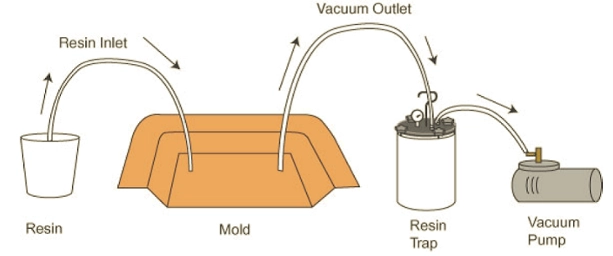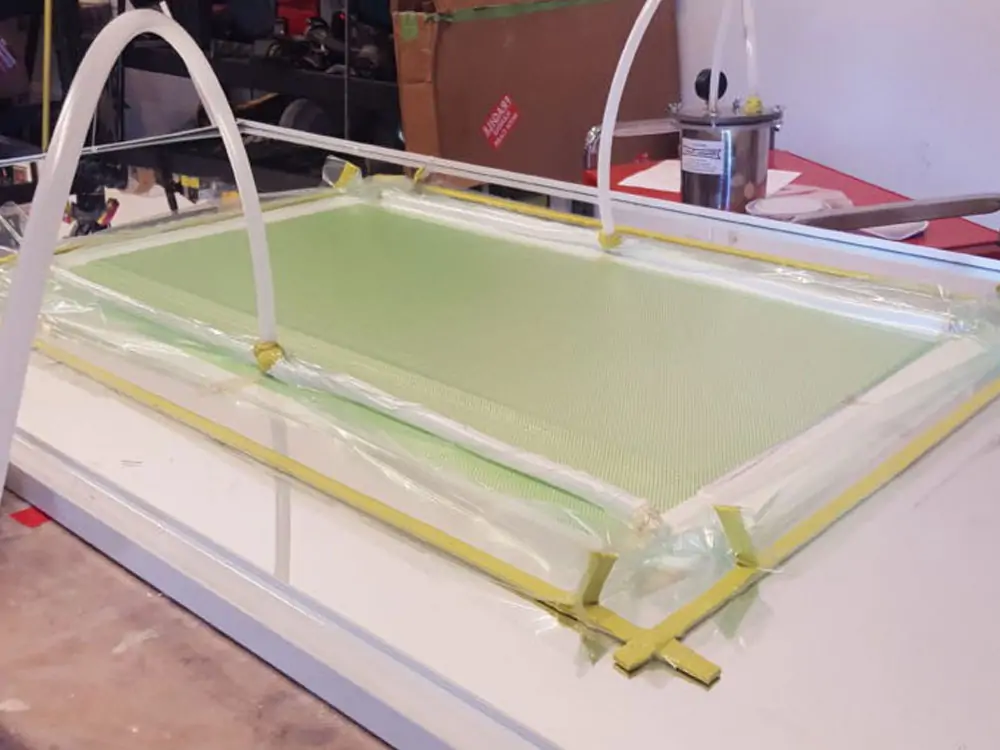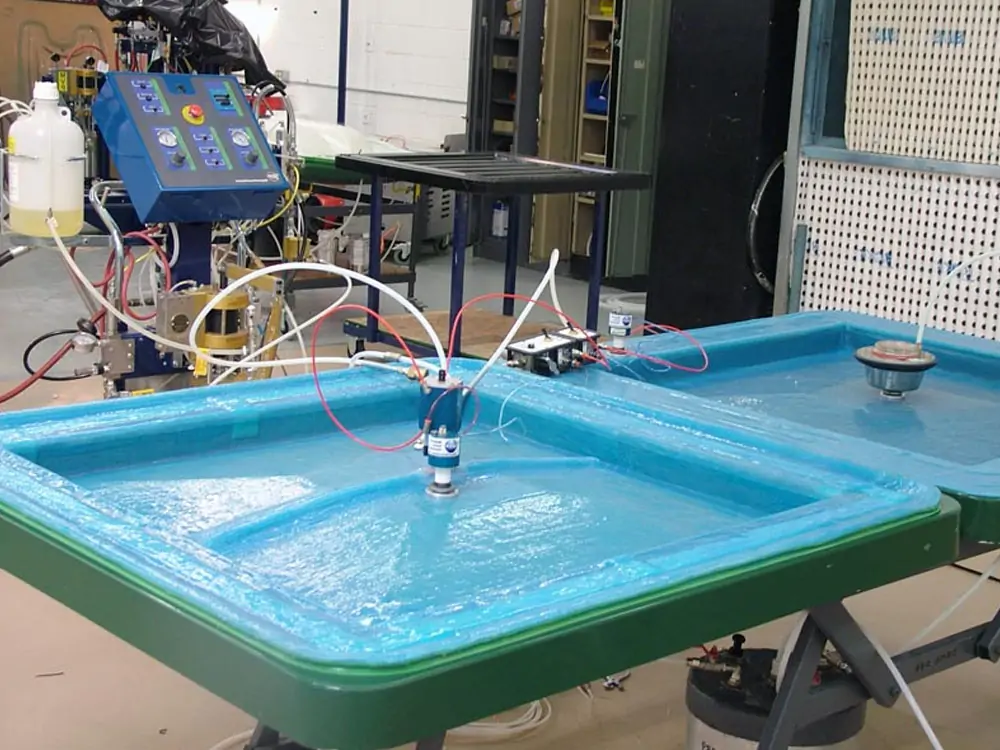In composite production, two factors reign supreme: precision and efficiency. These imperatives dictate the success of any manufacturing process. Among the techniques at our disposal, one method rises above all – the Vacuum Infusion Process. It represents the epitome of excellence in composite manufacturing. Vacuum Infusion Process is just not a process. It is a precision-engineered symphony of steps resulting in unparalleled-quality composite materials.
Vacuum Infusion Process Steps
First, the dry fiber materials get into a mold. It forms with plastic during the process. When the reinforcing components are in a vacuum completely. Then, the mold gets filled with liquid polymer resin in tubes. To spread resin throughout the fiberglass reinforcements, the hoover is useful. Vacuum infusion is a more time-consuming process than other techniques. It produces high-strength FRP pieces and shapes. They produce the most fiber-to-resin ratio.
1.Seal the Vacuum Bag
The process kicks off by sealing the dry fiber reinforcement and the mold in a vacuum-tight bag. This step ensures an airtight environment, which is crucial for the infusion process.
2.Start Vacuum Pressure
A vacuum pump creates negative pressure within the bag. This action removes air and gases, facilitating optimal resin infusion.
3.Introduce Resin
Once the vacuum pressure, builds, the resin is introduced. It flows through the reinforcement. Also, it saturates the fibers and creates a strong composite material.

4.Monitoring the Infusion
During the infusion, meticulous monitoring is essential. It involves observing the resin flow rates. It ensures even distribution and addresses potential issues.
5.Curing Process
After infusion, the composite undergoes a curing process. This allows the resin to harden. It results in a finished product of exceptional durability and strength.
Benefits of the RTM Process
The Vacuum Infusion Process offers various advantages. This makes it a preferred choice in composite production:

-
Enhanced Fiber-to-Resin Ratio
VIP achieves an optimal fiber-to-resin ratio, a critical factor in composite material strength. This ensures that every fiber gets covered in resin. VIP enhances the mechanical properties of the composite. This results in materials that are not only strong. But also lightweight. This makes them ideal for applications. It is a crucial consideration in the aerospace or automotive industries.
-
Reduce Environmental Impact
VIP is a responsible choice in composite production. Minimizing emissions and waste aligns with global efforts toward sustainability. Unlike some traditional methods that can generate excess material and emissions. VIP optimizes material usage. This makes it a greener option for manufacturers. It helps to reduce their ecological footprint.
-
Exceptional Surface Finish
One of the standout features of the RTM process is the exceptional surface finish. It imparts this finish to the composite. The process ensures that the composite material cures well. This results in a smooth, flawless surface. This reduces the need for extensive post-processing efforts. It saves time and resources in the manufacturing process.
-
Consistent Quality
VIP offers unparalleled control over resin distribution. This precision leads to consistent and reliable results in every production run. Manufacturers have confidence that each composite produced meets stringent quality standards. It provides peace of mind and assurance to end-users.
Drawbacks of the VIP Process
Understanding these drawbacks is important for manufacturers. This helps them to make informed decisions about its application.

- Time-Consuming Process
One notable limitation lies in the speed of production. Compared to some other molding techniques, VIP can be a time-consuming process. Achieving optimal resin infusion and curing requires meticulous attention to detail and patience. This may not be suitable for some industries. These industries need rapid turnaround times or high-volume production runs.
- Complex Set-up and Equipment
VIP demands specialized tools and materials. These include a vacuum system, airtight bags, and resin distribution networks. It is important to ensure the proper calibration and functionality of the components. This ensures a successful infusion. This initial investment in equipment can be significant, especially for smaller-scale operations.
- Complex Geometries
VIP excels in producing complex geometries. But, it may not be the most efficient method for all applications. For simpler, more straightforward shapes, other molding techniques may offer a cost-effective solution. Manufacturers need to assess the specific needs of their projects. Also, they have to weigh the advantages of VIP against other methods.
Applications of RTM Process
RTM process has found wide-ranging applications across various industries. This is due to its unique ability to produce lightweight and high-strength components. Here are three key sectors where VIP plays a pivotal role:
Aerospace Industry
In the aerospace sector, precision and performance are non-negotiable. The Vacuum Infusion Process emerges as a vital technique. This technique meets the demanding requirements of this industry. Weight savings are paramount in aerospace engineering. They impact fuel efficiency and performance.
Spacecraft and planes get an advantage from VIP-produced parts. The aerospace industry relies on the RTM process to create materials. These materials include fuselage panels and interior components. These materials can withstand the harsh conditions of outer space or high altitudes. This process allows for the incorporation of advanced materials. These materials offer a high strength-to-weight ratio. Thus, ensuring that aerospace vehicles are both durable and efficient.
Automotive Sector
VIP has become an indispensable tool in the manufacturing process. Automakers are seeking ways to reduce vehicle weight without compromising safety or performance. This produces body panels, interior components, and structural elements. These materials are not only lightweight but also durable.
Lighter vehicles need less energy to operate. This results in reduced fuel consumption and lower emissions. This aligns with the industry’s push towards more sustainable practices. The corrosion-resistant properties make them an ideal choice for withstanding various weather conditions. They also survive the road environments.
Marine and Boat Building
The ships and boats we use in the sea need special materials. They have to be strong enough to handle the salty water and tough conditions. This is where the Vacuum Infusion Process comes in. People who build boats use VIP to make the main parts like the hull, deck, and other important pieces. These parts are important for the boat to stay strong.
Materials made with VIP are super good at resisting corrosion, which is when things get damaged from salt water. This is important for boats. No matter if it’s a fun boat or a work boat, these materials can handle any situation. They can stay strong even if they’re in saltwater for a long time. The parts made with VIP are also very strong. This makes the boat even safer and makes it last longer.
VIP vs. Open Molding
- VIP characterizes its meticulous control over resin distribution. It utilizes vacuum pressure. This ensures fiber permeates every fiber, resulting in an optimal fiber-to-resin ratio. Open Molding may struggle to achieve the same level of uniform resin impregnation. This technique relies on the ambient atmosphere for the curing process. This leads to uneven resin distribution.
- When it comes to environmental impact, VIP holds a distinct advantage. Open Molding leads to excess material waste and emissions. This happens if the process does not perform well with precision. It contributes to a larger ecological footprint.
- Moreover, in complexity and versatility, VIP outshines Open Molding. The latter needs extensive adjustments or many steps to produce complex geometries. It increases production time and costs. Whereas, VIP is a cost-effective solution for industries that demand custom, complex components.
The Final Thoughts
In making things from different materials, VIP is like a bright light showing us how to do it better and faster. Its special features and benefits not only make it a good choice. But, the very best option for many different types of businesses. Vacuum Infusion Process is super important in making things from different materials. It’s accurate, good for the environment, and can be used in many different ways. This way of making things is one of the most important in modern ways of manufacturing. It’s a trustworthy and smart choice for many different kinds of businesses. This includes making things with better quality, faster, and better for the environment. In making things from different materials, VIP is like a bright light showing us how to do it better. It’s a great example of new ideas, doing things better, and taking care of our environment.
